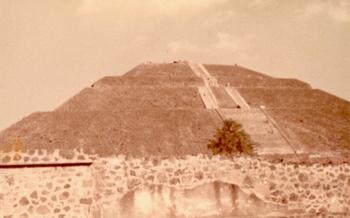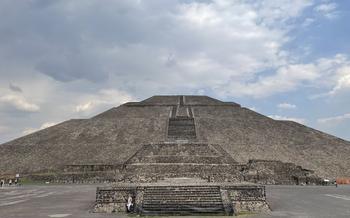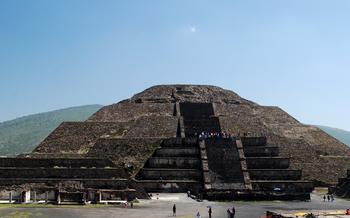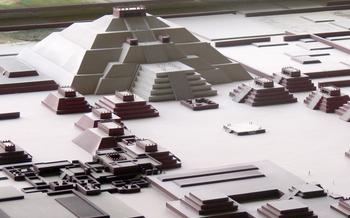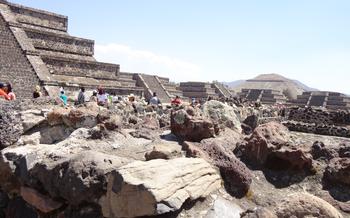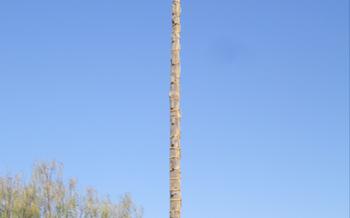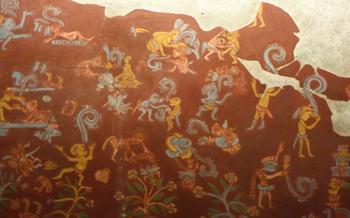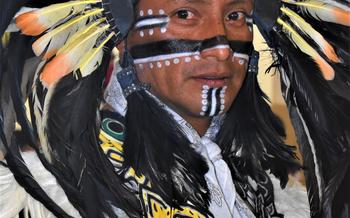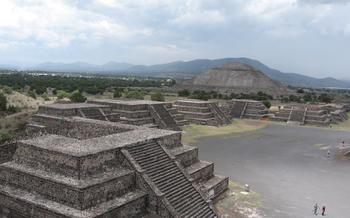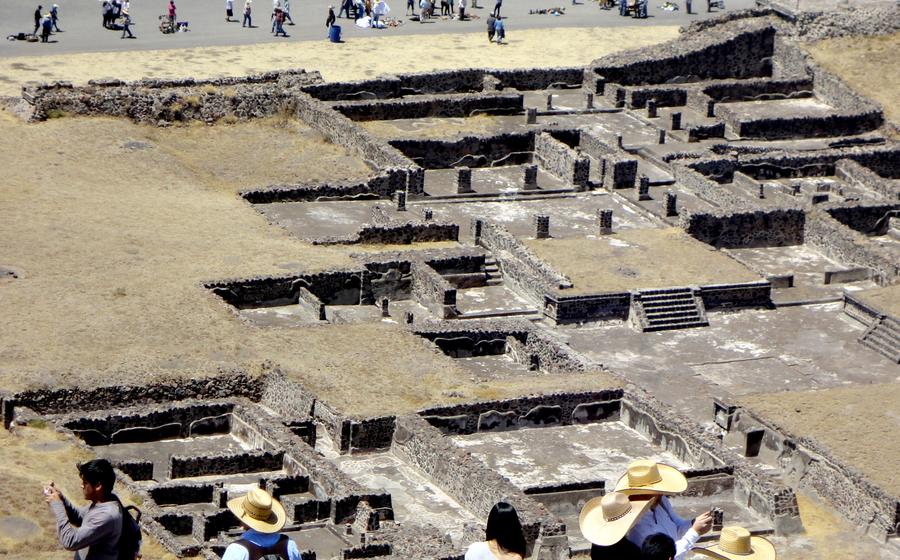
Plaza de las Tres Culturas
- Plaza de las Tres Culturas: A Crossroads of Civilizations
- Exploring the Pyramid of the Sun
- Architectural Marvel
- Symbolic Meaning
- Climb to the Top
- Insider Tip
- Discover the Pyramid of the Moon
- Unraveling the Avenue of the Dead
- Journey into the Teotihuacan Museum
- Witness the Nighttime Illuminations
- Explore the Lesser-Known Pyramids
- Uncover the Secrets of the Tunnels
- Experience the Vibrant Festivals
- Admire the Views from the Cerro Gordo Pyramid
- Discover the Archaeological Zone
- Learn about the Water Management System
- Insider Tip:
- Insider Tip: Plan Your Visit
Plaza de las Tres Culturas: A Crossroads of Civilizations
The Plaza de las Tres Culturas, meaning "Plaza of the Three Cultures," is a remarkable site in the heart of Teotihuacan, Mexico. It is a captivating blend of ancient history and modern urban life, where towering pyramids, Spanish colonial churches, and contemporary buildings converge.
This unique plaza has been a witness to the rise and fall of civilizations, from the ancient Teotihuacans, who built the magnificent pyramids, to the Spanish conquistadors, who brought Catholicism and colonial architecture, to the modern-day Mexican people who continue to honor their cultural heritage.
Main Attractions and Cultural Significance:
-
Pyramid of the Sun: This awe-inspiring pyramid, the largest in Teotihuacan, was constructed as a temple dedicated to the sun god. Its impressive size and architectural achievements showcase the advanced engineering skills of the ancient Teotihuacans.
-
Pyramid of the Moon: Although smaller in size, the Pyramid of the Moon holds great significance as it was aligned with the movements of the moon and was dedicated to the moon goddess.
-
Temple of Quetzalcoatl: Located at the base of the Pyramid of the Moon, this temple features elaborately carved feathered serpent heads and is dedicated to the god Quetzalcoatl, a central figure in Mesoamerican mythology.
-
Church of Santa María de Guadalupe: This 16th-century church represents the Spanish colonial influence in Teotihuacan and stands as a testament to the blending of cultures that occurred during that period.
Unique Experiences:
-
Climb to the Top of the Pyramids: Experience the thrill of climbing to the top of the Pyramid of the Sun or the Pyramid of the Moon for breathtaking views of the entire archaeological site and the surrounding valley.
-
Attend a Traditional Ceremony: Immerse yourself in the spiritual traditions of the ancient Teotihuacans by participating in a traditional ceremony conducted by local shamans.
Interesting Fact:
The Plaza de las Tres Culturas is a UNESCO World Heritage Site, recognizing its outstanding universal value as a unique example of cultural continuity and interaction between different civilizations.
Exploring the Pyramid of the Sun
Architectural Marvel
The Pyramid of the Sun, the largest structure in Teotihuacan, stands as a testament to the architectural prowess of the ancient Teotihuacans. Rising an impressive 216 feet above the ground, it is the third-largest pyramid in the world by volume. Its construction involved the movement of an estimated 2 million tons of earth and rock, a feat that required meticulous planning and engineering skills. The pyramid's four sides align perfectly with the cardinal points of the compass, demonstrating the Teotihuacans' advanced knowledge of astronomy and mathematics.
Symbolic Meaning
The Pyramid of the Sun holds deep religious and cultural significance. It was believed to be the earthly representation of Mount Tlaloc, the sacred mountain associated with the rain god Tlaloc. The pyramid's alignment with celestial events, such as the summer solstice, further supports this connection to the divine. The pyramid's interior contains a series of tunnels and chambers, which were likely used for religious rituals and ceremonies.
Climb to the Top
Climbing to the top of the Pyramid of the Sun is a must-do experience for visitors to Teotihuacan. The ascent involves climbing 248 steep steps, but the effort is rewarded with breathtaking panoramic views of the surrounding valley and the entire Teotihuacan complex. The summit also offers a unique perspective on the pyramid's massive scale and intricate construction.
Insider Tip
To avoid the crowds and heat, it's best to visit the Pyramid of the Sun early in the morning or late in the afternoon. During the summer months, it's advisable to bring plenty of water and wear sunscreen to protect yourself from the intense sun.
Discover the Pyramid of the Moon
Though smaller in size compared to its neighboring Pyramid of the Sun, the Pyramid of the Moon holds equal significance in the story of Teotihuacan. Dedicated to the moon goddess, it played a crucial role in religious ceremonies and rituals. At its base lies the Temple of Quetzalcoatl, a testament to the cult of Quetzalcoatl, the feathered serpent god.
-
Smaller Yet Significant: While the Pyramid of the Moon may not match the grandeur of its solar counterpart, its importance lies in its association with the lunar deity, a central figure in Teotihuacan's religious beliefs.
-
Divine Purpose: The pyramid's alignment with the moon's cycles suggests its use as an astronomical observatory. It is believed that priests observed the moon's movements from the pyramid's summit, using this knowledge to guide religious ceremonies and agricultural practices.
-
Temple of Quetzalcoatl: At the pyramid's base lies the Temple of Quetzalcoatl, a masterpiece of Mesoamerican architecture. Its intricate carvings and sculptures depict the feathered serpent god and other significant figures from Teotihuacan's mythology.
-
Insider Tip: Visit the Pyramid of the Moon during the spring or autumn equinoxes. The sun aligns perfectly with the pyramid's central staircase, creating a captivating visual spectacle as sunlight illuminates the temple's interior.
Unraveling the Avenue of the Dead
The grand Avenue of the Dead (Miccaotli), stretching for over 2 kilometers, served as the central axis of Teotihuacan. This majestic pathway connected the main pyramids, the plazas, and other significant structures, forming the heart of the ancient city. Along its length, visitors can admire various temples, platforms, and residential compounds, each contributing to the city's rich history.
The Avenue of the Dead held immense ceremonial significance, serving as a stage for religious processions, rituals, and public gatherings. It provided a sacred route for the movement of priests, rulers, and deities during important ceremonies. Flanking the avenue, visitors can explore numerous structures, including the Temple of Quetzalcoatl, the Pyramid of the Moon, and the Ciudadela, each showcasing unique architectural styles and intricate carvings that offer glimpses into the lives and beliefs of the Teotihuacan people.
To fully appreciate the grandeur and scale of the Avenue of the Dead, consider renting a bicycle or exploring it on foot. This immersive experience allows visitors to soak in the atmosphere, admire the surrounding structures, and connect with the ancient city's vibrant past.
Journey into the Teotihuacan Museum
Situated near the Plaza de las Tres Culturas, the Teotihuacan Museum houses a treasure trove of artifacts unearthed from the ancient city. Step inside to embark on a journey through time and discover the fascinating world of the Teotihuacan civilization. The museum's collection showcases exquisite pottery, intricately carved sculptures, and vibrant murals that bring to life the daily lives, beliefs, and customs of this enigmatic people.
Interactive displays and multimedia presentations enhance the museum experience, providing deeper insights into the city's history, architecture, and social structure. Learn about the advanced mathematical and astronomical knowledge possessed by the Teotihuacans and how it influenced their urban planning and religious practices.
To fully appreciate the museum's exhibits, plan to spend at least two hours exploring its galleries. Arrive early to avoid crowds and take your time to absorb the rich cultural heritage on display. The museum also offers guided tours in various languages, led by knowledgeable experts who can provide additional context and insights into the Teotihuacan civilization.
Insider Tip: To avoid the crowds and have a more intimate experience, visit the museum early in the morning or during the off-season months (November to March).
Witness the Nighttime Illuminations
As darkness falls over the Plaza de las Tres Culturas, a magical transformation takes place. The ancient ruins are bathed in a warm glow, casting intricate shadows that bring the site to life in a new and captivating way. A mesmerizing sound and light show illuminates the towering pyramids, telling the story of Teotihuacan's history and culture through vibrant projections and evocative music. This immersive experience transports visitors back in time, offering a unique perspective on the ancient city and creating lasting memories. To fully appreciate this spectacle, book your tickets in advance, especially during peak tourist season, to secure a spot for the show and avoid disappointment.
Explore the Lesser-Known Pyramids
Beyond the iconic Pyramid of the Sun and Moon, Teotihuacan boasts several other noteworthy pyramids that offer a unique and less crowded experience. These hidden gems, scattered throughout the vast archaeological zone, provide a diverse perspective on Teotihuacan's architecture and historical development.
The Pyramid of the Feathered Serpent, located north of the Pyramid of the Sun, is one such hidden gem. While smaller in size, it is distinguished by its intricate carvings and sculptures depicting the Feathered Serpent, a revered deity in Mesoamerican mythology.
Another lesser-known pyramid is the Pyramid of the Moon's Twin, located directly opposite the Pyramid of the Moon. Although smaller in height, it mirrors the Pyramid of the Moon in its design and orientation, suggesting a significant religious or ceremonial purpose.
Venture further into the archaeological zone to discover the Pyramid of the Sun's Twin, which offers a unique insight into the city's urban planning. Located directly west of the Pyramid of the Sun, it is believed to have been built as a counterpart to the city's main pyramid, creating a symmetrical layout.
These lesser-known pyramids provide an opportunity to explore the diversity of Teotihuacan's architectural achievements and gain a deeper understanding of the city's complex urban structure. Remember to bring comfortable shoes and plenty of water as you embark on your adventure to discover these hidden treasures.
Uncover the Secrets of the Tunnels
Beneath the sprawling city of Teotihuacan lies a hidden world—a network of tunnels that offers a glimpse into the ancient civilization's secrets and rituals. Discovered in the 1970s, these tunnels have yielded a wealth of archaeological treasures, including burials, offerings, and evidence of ritual activities.
One of the most intriguing aspects of the tunnels is their purpose. While some believe they were used for drainage or storage, others suggest they had a more ceremonial or religious significance. Some theories even propose that the tunnels were part of an elaborate underworld system, connecting the living world with the realm of the dead.
Exploring the tunnels is a unique and unforgettable experience. Visitors can book guided tours that take them through the dark and mysterious passageways, revealing the secrets of Teotihuacan's hidden world. Along the way, they will encounter fascinating artifacts, learn about the city's ancient beliefs, and gain a deeper appreciation for the ingenuity and complexity of this ancient civilization.
Experience the Vibrant Festivals
Teotihuacan comes alive during its many colorful festivals and celebrations, which showcase the region's rich cultural heritage. The Festival of the Dead, or Día de los Muertos, is a particularly special time to visit, as the city is adorned with vibrant marigolds and altars honoring the deceased. Traditional dances, such as the Danza de los Concheros, fill the streets, and the air is filled with the sounds of music and laughter. Indulge in the delicious traditional food and beverages offered at the festival stalls, and immerse yourself in the local culinary scene. Plan your visit to coincide with one of these major festivals for a truly immersive and unforgettable experience.
Admire the Views from the Cerro Gordo Pyramid
Ascend the ancient steps of the Cerro Gordo pyramid, a hidden gem within the Teotihuacan complex, and be rewarded with breathtaking panoramic vistas. From this elevated vantage point, the entire city unfolds before your eyes, its majestic pyramids, temples, and plazas stretching out in a mesmerizing display of urban planning. Gaze upon the Avenue of the Dead, the city's central artery, as it cuts through the heart of Teotihuacan, connecting the major pyramids and ceremonial centers. Let your eyes wander beyond the city limits, taking in the surrounding valley and the distant mountains that frame this ancient metropolis. Capture the essence of Teotihuacan's grandeur and the natural beauty that envelops it from this unique perspective.
Discover the Archaeological Zone
Beyond the main attractions of the Plaza de las Tres Culturas, the vast archaeological zone surrounding it holds countless treasures waiting to be explored. Numerous unexcavated ruins and structures lie scattered across the landscape, offering a glimpse into the city's expansive history. Ongoing archaeological excavations and research continue to shed light on Teotihuacan's rich culture and uncover new insights into the lives of its inhabitants. From hidden temples and residential complexes to workshops and ceremonial centers, the archaeological zone provides a fascinating journey into the past. Join a guided tour to gain in-depth knowledge and uncover the hidden stories of this ancient metropolis.
Learn about the Water Management System
The Teotihuacans were renowned for their advanced water management system, which played a crucial role in sustaining their civilization. They constructed an intricate network of canals, reservoirs, and dams to harness and distribute water effectively throughout the city. This system not only supported agriculture, providing water for irrigation, but also held symbolic and ritualistic significance. Water was considered sacred, associated with fertility, life, and divine power. The Teotihuacans incorporated water features into their urban design, creating sacred springs, fountains, and pools that served both practical and ceremonial purposes. Exploring the water management system of Teotihuacan offers a fascinating glimpse into the ingenuity and cultural beliefs of this ancient civilization.
Insider Tip:
Visit the Museo del Agua (Water Museum) to delve deeper into the water management system of Teotihuacan. The museum showcases interactive exhibits, models, and artifacts that provide a comprehensive understanding of how the Teotihuacans harnessed and utilized water resources.
Insider Tip: Plan Your Visit
To make the most of your visit to Teotihuacan, careful planning is essential. The best time to visit is during the shoulder seasons (April-May and September-October) when the weather is pleasant, and the crowds are smaller. Avoid visiting during the summer months (June-August) when temperatures can soar, and the site is packed with tourists. Pack comfortable shoes, a hat, and sunscreen, as you'll be doing a lot of walking under the sun. Bring a camera to capture the stunning sights, and consider hiring a guide to enhance your understanding of the site's history and significance. Reaching Teotihuacan is easy, with various transportation options available. You can take a bus from Mexico City's Terminal Central de Autobuses del Norte, which takes about an hour. Alternatively, you can join a guided tour that includes transportation from your hotel in Mexico City. Safety is generally not a concern in Teotihuacan, but it's always advisable to be vigilant and take precautions. Stay hydrated, be aware of your surroundings, and avoid walking alone at night. Respect local customs and traditions, and ask for permission before taking photos of people.
